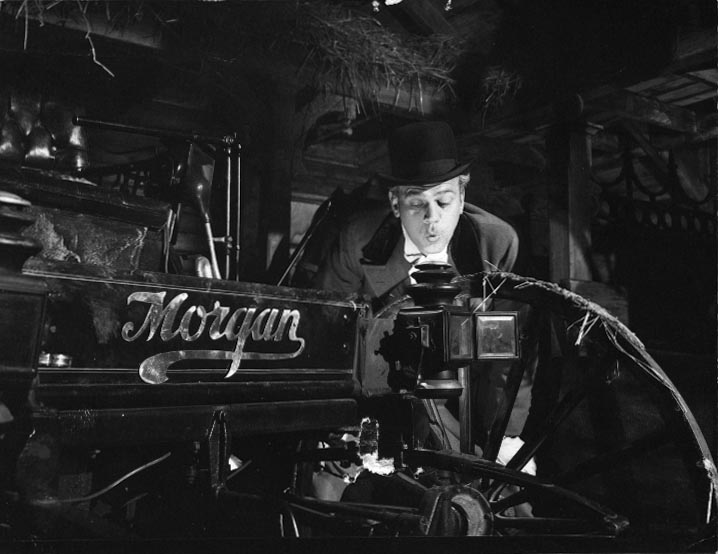
Eugene Morgan (Joseph Cotton) demonstrating one of his automobile prototypes, from Orson Welles’s film The Magnificent Ambersons (RKO Pictures, 1942)
Here’s the first installment of Curbing Cars @ The Movies, in which our Research Director Rick Meier explores four cinematic visions of the future of cars and driving. In Part 1, we look back to turn of the 20th century, and the invention of the automobile. We see how the horseless carriage transformed the idyllic, pre-industrial city of Indianapolis, in Orson Welles’ The Magnificent Ambersons (1942).
By Rick Meier
In 1942, immediately following his spectacular debut in Citizen Kane, Orson Welles delivered his second feature release to RKO Pictures: an elegant adaptation of Booth Tarkington’s Pulitzer Prize-winning novel The Magnificent Ambersons (originally published in 1918).
It is the story of the once grand and prosperous Ambersons: rich and influential property owners in a small but thriving “Midland town” (based on Tarkington’s native Indianapolis, during the opening years of the 20th century).
Welles opens his film with a series of vignettes portraying the way it used to be in sleepy, pre-industrial Indianapolis. In the first vignette we learn that, “back in those days” the only public convenience was the streetcar, and one on which the rules of chivalry were not yet dead.
The film follows the great Amberson family and its ever-watchful neighbors as succeeding generations of Amberson heirs fail to maintain the great wealth and position won by their patriarch, Major Amberson. Faithful to Tarkington’s novel, Welles’s adaptation is set against the backdrop of America’s second industrial revolution (also known as the technological revolution). Behind each personal tragedy of the Ambersons we perceive the changing world of their bustling community as their quaint Midland town progressively spreads and darkens into a modern city.
Ultimately, the greatest threat to the eminence of the Ambersons comes from the newly invented automobile. The family’s prospects begin to dwindle as the Amberson-owned houses on National Avenue (a district based on the real-life neighborhood of Woodruff Place, in Indianapolis) start to depreciate in favour of newer upscale suburban neighborhoods, now more accessible by car, and located further and further away from the increasingly smoky and bustling industry of the downtown core.
In a crucial scene, George—the current Amberson heir—disparagingly characterizes the automobile as a useless nuisance, giving rise to an insightful speech from the automobile manufacturer and family friend, Eugene Morgan (played by Joseph Cotton), about the ways automobiles could potentially impact human life.
The subtext that drives the Magnificent Ambersons is the story of how the rise of driving gave birth to the suburb. Here at Curbing Cars we look at the still-unfolding story of how the now increasing burdens of car ownership is coinciding with an historic period of re-urbanization.

Tune in next week for the second installment in this four-part series on cars in cinema, featuring Minority Report (2002)
